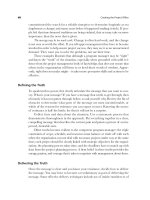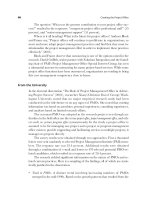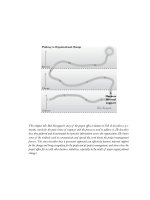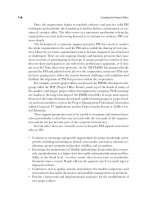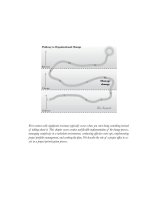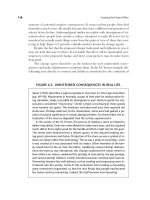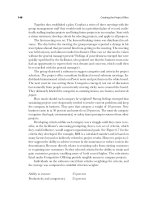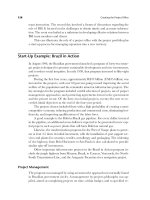Tài liệu Creating the project office 27 pdf
Bạn đang xem bản rút gọn của tài liệu. Xem và tải ngay bản đầy đủ của tài liệu tại đây (77.68 KB, 10 trang )
total). As of this writing, the Group Program Office has been resized to four to
meet current business demands. The three divisions that implemented Divisional
Program Offices have two to three people in each office.
Lessons Learned
Setting up of a program office is all about improving business performance. Rowe
believes the processes used need to become second nature to the people running
the business. To achieve this they must be very easily integrated into the day to
day business. Complicated systems with lots of bells and whistles are generally not
acceptable as they distract people and prevent them from being high performers.
Rowe also believes that there is not any one system or process that will fit every
organization, therefore, a program office has to be tailor-made for the business.
This means that the best people to set up program offices should have a good un-
derstanding of the culture of the business.
The program office must be closely linked to the top of the business and to
decision makers. Progress on projects and programs is often slowed because man-
agers do not understand or have not been communicated with. Therefore, one
key role of program managers is to be able to influence key senior people. When
this ability exists and is exercised, roadblocks get removed.
A program office should have clear and well understood processes, but should
not live only by these processes. The role is to drive value for the business (and
therefore for the shareholders). If PO processes are gold plated and business per-
formance is down, then the PO is not doing what it needs to be doing. Rowe says,
“Businesses that are doing this stuff well are getting results by integrating robust
changes into the culture of the business; they are not shouting from the rooftops
that they are running programs with great systems to drive improvement.”
Project Management in Action
The following outline documents a response to the Australian Stock Exchange re-
quest concerning the Y2K problem as it related to Goodman Fielder Limited.
Background.
Goodman Fielder’s principal activities are the manufacture and sale
of consumer foods and ingredients. Major product areas include grain-based
products such as bread and breakfast cereals, edible oils such as margarine and
cooking oil, food ingredients, and poultry.
Goodman Fielder recognized the potential seriousness of the Y2K problem
in early 1997 and implemented measures in all its Australian and overseas opera-
tions designed to minimize exposure. The Y2K problem was addressed as a matter
of priority, and Goodman Fielder aimed to be Y2K-ready by October 29, 1999.
238 Creating the Project Office
Goodman Fielder’s Y2K program commenced in mid-1997 with the en-
gagement of a firm of independent consultants to conduct a comprehensive as-
sessment of the extent of the problem within the organization.
The assessment, and the recommendations it contained, were the precursor to
Goodman Fielder’s formal Y2K program. The goal of the program was to en-
sure that the susceptible systems, suppliers, customers, and logistics chains criti-
cal to their organization continue to operate normally during the transition to the
year 2000 and thereafter. In this way they minimized any adverse material affect
on the organization as a whole.
Y2K Readiness.
On its Web site, Goodman Fielder referred to Y2K readiness as:
“Ensuring Goodman Fielder and its operations have addressed those components
of the business that are exposed to the Year 2000 problem. In doing so, Good-
man Fielder looks to ensure that the risk of any adverse impact to the conduct of
business resulting from the issue has been removed or reduced to a level whereby
it is not significant.”
Project Structure.
A program office was established to manage and coordinate
Y2K activities across the organization. The project office was headed by the
Goodman Fielder Y2K project manager, who reported to the Y2K Executive
Steering Committee, which consisted of the chief financial officer, the chief in-
formation officer, and a representative from the internal auditors, Deloitte Touche
Tohmatsu. A regular reporting mechanism was implemented, which included
monthly reports to the Board of Directors, the Audit Committee, and the Exec-
utive Committee.
To facilitate the project, nine project teams were assembled, each represent-
ing a division of the organization. Each team was headed by a designated project
manager who in turn reported to the Y2K Program Office.
A significant observation about successful project office implementations is
that they occupy a prominent, visible, and important position on the organization
chart. The Y2K example reflects a sense of urgency, a vision about the desired
outcome, and how an important project needs a project office reporting high up
in the organization (alignment with powerful forces), which offers them a promi-
nent and authoritative role to complete a mandatory program that by itself is not
a project people want to do.
Maturity
Maturity models offer a means to assess where an organization currently resides
with regard to where it can be along a continuum of progression within a dis-
cipline of knowledge. Refer to Crawford (2001) and Kerzner (2001) for detailed
In or Out? 239
descriptions of project management maturity models. A project office is usually
established by the time an organization reaches higher levels of maturity. Keep in
mind how many people accept, are uncomfortable with, or integrate the change
when gauging the project maturity of your organization. Chapter Five describes
the dialogue that a maturity model offers within the 3M Company. Here we offer
a few more words about how maturity affects the operation of a project office.
A strategic project office monitors the progress and effectiveness of the change
to the organization and makes adjustments as necessary. Kent Crawford of PM
Solutions, a former PMI president, says it is possible to prepare people for cul-
tural change by helping them accept ambiguity, prepare for possible scenarios,
have fun in order to survive, forget consensus (conquer through collaboration),
adopt to life in the chasm (that space between the known and the unknowns), and
recognize a task is for today while the system is for always.
Implementing a project office is an organizational change project, and exec-
utive sponsorship is important. Crawford also believes that without an executive
sponsor, the chances of successfully deploying a project office are very slim. The
more influential the sponsor, the greater the likelihood of success. Identify a
project sponsor and increase management participation by establishing a project
office steering committee. This steering committee may be the guiding coalition
you establish to begin the process, or it may consist during later stages of matu-
rity as a dedicated group of upper managers committed to overseeing the con-
tinuous improvement of project management across the organization. As the
organization matures further and the project management process becomes the
normal operating condition, the role of this group and the urgency of its work
may diminish.
Ideally, the head of the strategic project office is a director of project man-
agement who sits at a director or vice presidential level with other senior execu-
tives in the organization. Other members of the project office are project managers,
project mentors, project planners, project controllers, and methodology experts,
along with a library and documentation specialist, an administrative support co-
ordinator, a communications coordinator, an issue resolution and change control
coordinator, and a risk management coordinator. Higher levels of maturity display
these titles prominently on the organization chart.
Other advice to increase program management maturity: Ensure that ex-
pectations and goals are shared and that the charter for the project office deploy-
ment project is endorsed by all stakeholders. Do not try to do too much too
soon—start with the basic needs and start up the office to help project teams. One
way to fail is to work in a vacuum. In a project office implementation, a team ap-
proach wins. Organizations advance as they formally recognize teamwork and as
they flexibly modify the role of the project office to support changing organiza-
tional requirements.
240 Creating the Project Office
Operating HP’s Project Management Initiative
Since the rise and fall of a project office is another prominent theme, let us look
at steps along this path. Previous work (Graham and Englund, 1997, Chapter 9)
described the Project Management Initiative at Hewlett-Packard Company. This
investment focused on corporate resources to help people anywhere and every-
where in the organization improve the environment and skills for effective project
management. Figure 9.6 reflects a timeline and update.
Events in the company’s response to competitive time-to-market needs in-
voked an assessment of its project management needs. The initiative has been a
stabilizing factor. The PM Council, a guiding coalition, helped get it started but
lost relevance when the initiative was established and self-funded. Figure 9.6 shows
it disbanding after the first few years.
Training was an ongoing activity, supplemented by concise documented
process sheets. Conferences were held every two years until large attendance made
them too visible (and perceived as expensive).
In or Out? 241
FIGURE 9.6. A TIMELINE OF ACTIVITIES AND PEOPLE IMPACT AT HP.
Situation assessment
1989 1990 1991 1992 1993 1994 1995 1996 1997 1998 1999 2000
People Impact
Project management initiative
PM council
Training
Information resources
PM conferences
Consulting
Self-funding
Upper management conference
Business initiatives
Web site
WebShops
Regional training events
Consulting was added when everyone realized that training was not enough.
Self-funding (an internal market model) came about as part of a corporate func-
tions initiative to ensure corporate activities added value, not just expense. It
changed the whole focus for the group.
An upper management conference helped address the leadership’s role in cre-
ating an environment for successful projects. Business initiatives also addressed
upper managers, working to ensure they were both supportive of the project man-
agement effort and trained on what project management involves.
The Web site and “WebShops”—Web-based workshops—facilitated wide-
spread communications of the initiative offerings and online distance learning.
Regional training events, where all courses are offered on site over an intense two-
week period, helped fill the void left by discontinuation of the PM conferences.
The people impact line (cumulative) show a big increase when the initiative
became self-funded, due to extensive marketing and introduction of new work-
shops. Progress was slow in 1997 because of company-wide cost constraints. Im-
pact picked up again due to alternative delivery of WebShops and regional
training events coming to division sites.
Funding a Project Office: A Cyclic Adventure
No simple answer exists for how to fund the project office. HP did it both ways
and keeps swinging. It started with corporate funding, switched dramatically to a
self-funding model, and then back to corporate.
Self-funding requires extensive marketing efforts to communicate offerings
and motivate people to buy the services. It requires a focus on value—courses,
written materials, conferences, consulting, and online workshops need to offer
practical steps to take for immediate action. The HP initiative dramatically
stepped up development of new workshops and other offerings when its survival
depended on self-funding. This led to a positive quantum jump in its effectiveness
and impact on the organization.
Self-funding requires shameless selling. That marketing effort may mark its
downfall. Marketing takes time and effort, and that effort takes away from devel-
oping new products and value-added services (unless the initiative balances its port-
folio to include these activities). Internal customers become annoyed with endless
e-mail marketing campaigns about course offerings. The problem compounds when
numerous corporate programs advertise through the same channels. Divisions typ-
ically ask corporate groups to get their acts together into one package. However, de-
veloping that package is a massive program itself—and is quickly abandoned.
Leadership needs to be clear about the purpose and focus it wants from the
project office. Self-funding may be appropriate if the PO is viewed as a stand-
242 Creating the Project Office
